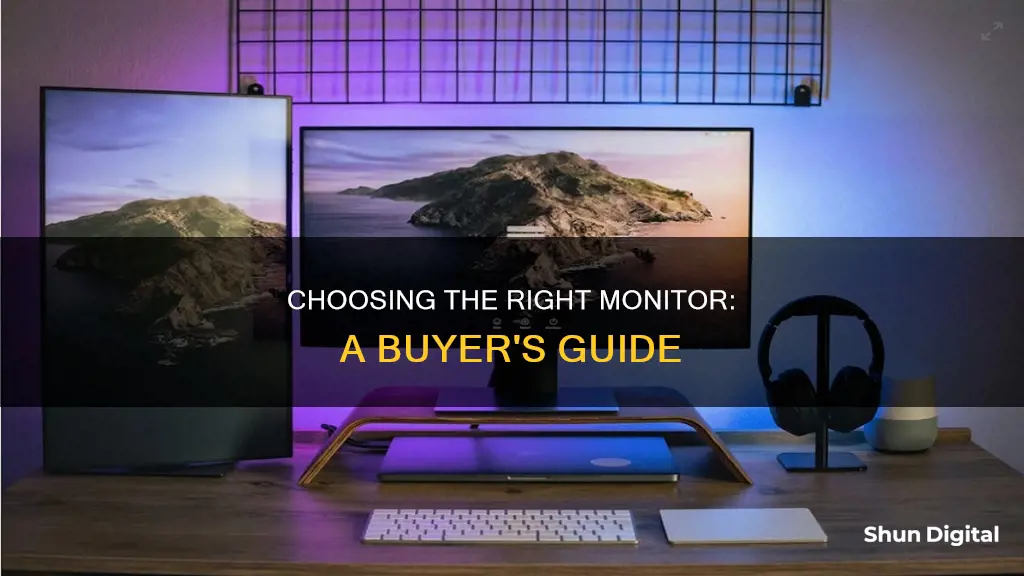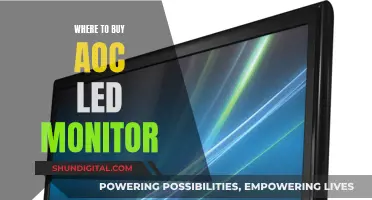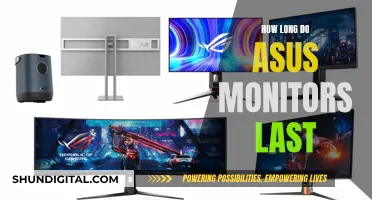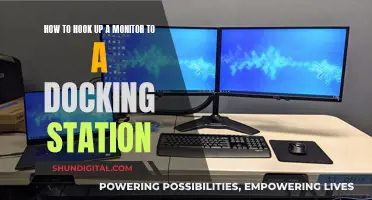
Choosing the right monitor can be a daunting task, but it's important to select one that suits your specific needs. The first step is to determine your budget and the purpose of the monitor, whether it's for gaming, professional use, or general use. Next, consider the technical specifications such as screen size, resolution, panel type, refresh rate, brightness, contrast ratio, response time, and viewing angle. Other features like USB hubs, adjustable stands, and integrated speakers can also enhance your experience. By knowing your requirements and understanding the available options, you can make an informed decision when purchasing a new monitor.
| Characteristics | Values |
|---|---|
| Purpose | Gaming, professional or general use |
| Resolution | 1920 x 1080 (Full HD/FHD/HD), 2560 x 1440 (QHD/WQHD/1440p), 3840 x 2160 (4K/UHD), 5120 x 2160 (5K) |
| Size | 23-24", 27", 32", 34" and above |
| Aspect Ratio | 16:9, 16:10, 21:9, 5:4, 4:3 |
| Panel Type | TN, IPS, VA, OLED |
| Refresh Rate | 60Hz, 75Hz, 120Hz, 144Hz, 240Hz, 360Hz |
| Response Time | 5ms, 0.5ms, 8ms |
| Ports | VGA, DVI, HDMI, DisplayPort, USB-C |
| Brightness | 250 cd/m2, 350 cd/m2, 300 nits, 600 nits |
| Contrast Ratio | 350:1, 5,000:1, 600,000:1 |
| Colours | 16.7 million (24-bit) |
| Viewing Angle | 178°, 170°, 180° |
| Mounting | VESA |
| Other Features | USB hub, curved screen, adjustable stand, integrated speakers/camera, daisy chain, picture-in-picture, multiple inputs |
What You'll Learn

Budget
If you are looking for a monitor for general home use, it may be more cost-effective to purchase an all-in-one computer, where the monitor and computer are integrated. This will save you the hassle and cost of buying a separate monitor. However, if you already have a computer and just need a new or additional monitor, then the main considerations are size, resolution, and price.
When it comes to size, bigger is not always better. While larger monitors can provide a more immersive experience, particularly for gaming or graphics-related tasks, they can also be more expensive and may not fit comfortably on your desk. A good rule of thumb is to choose a monitor that is 27 inches or larger if you plan to use it for gaming or graphics-intensive work, and a smaller monitor for general-purpose use.
Resolution is another key factor to consider when buying a monitor on a budget. The resolution refers to the total number of pixels on the screen, and higher resolutions generally provide sharper and more detailed images. While 1920x1080 (also known as 1080p or Full HD) is the standard resolution for most monitors, higher resolutions such as 2560x1440 (2K or 1440p) or 3840x2160 (4K or Ultra HD) will offer improved picture quality. However, keep in mind that higher resolutions can also increase the price, so it's important to balance your budget with your desired features.
In addition to size and resolution, there are other factors to consider when buying a monitor on a budget. Here are some tips to help you get the best value for your money:
- Compare prices from different retailers, as monitor prices can vary significantly, and you may find the same monitor for a lower price elsewhere.
- Look for sales and discounts, as monitors often go on sale, and you may be able to find a good deal.
- Prioritize the features that are most important to you, such as fast refresh rates or low response times for gaming, or accurate color reproduction for professional use.
- Consider buying a used or refurbished monitor, which can offer significant savings over a new monitor.
- Read reviews from other customers to get an idea of the quality and performance of the monitor before purchasing.
By following these tips and considering your budget, you can find a monitor that fits your needs and provides the best value for your money.
Monitoring Internet Usage: Real-Time Surveillance and Security
You may want to see also

Purpose
The purpose of your monitor will determine the features you should look for. Here are some common purposes for monitors and the features that are important for each:
Gaming
If you're a gamer, your monitor is a very important component of your setup. Here are some key features to look for:
- Fast refresh rates and low response times: A higher refresh rate means smoother images and less choppy motion. A refresh rate of 75Hz is the minimum recommended for gaming, with 120Hz or more being ideal. Response time refers to how long it takes for a monitor to change individual pixels from black to white, and longer response times can lead to motion blur. Look for a response time of 5ms or less.
- High resolution: A higher resolution will give you sharper images. The minimum you need is 1920 x 1080 (1080p), but you'll get better image quality with QHD or 4K.
- Low latency: This is important for reducing input lag, which is the time it takes for your monitor to recognize output from your graphics card.
- Adaptive-sync technology: Both Nvidia G-Sync and AMD FreeSync reduce screen tearing and stuttering. G-Sync tends to be more expensive, but both technologies add to the price of the monitor.
- High contrast: Look for a VA panel for the best contrast and image depth.
Professional Use
If you work in a field such as photography, graphic design, or video production, you'll want a monitor that's designed for content creation. Here are some key features to look for:
- Large screen: A larger screen gives you more space for your work and lets you see finer details. A 27-inch or larger monitor is recommended.
- High resolution: Look for a resolution of at least Full HD, with Quad HD or 4K being ideal.
- Colour accuracy: An IPS panel offers deep blacks, accurate colours, and wide viewing angles, making it a good choice for professionals.
- Fast response time: For tasks like video editing, a response time of 5ms or less will reduce motion blur and ghosting.
- Adjustability: An adjustable stand or dual-display mount will allow for easy, ergonomic viewing.
- Calibration options: Look for options to calibrate your display for different colour gamuts, colour temperatures, and gamma curves.
General Use
If you're using your monitor for everyday tasks like browsing the web, streaming music and movies, or using productivity software, you don't need as many bells and whistles. Here are some key features to look for:
- High contrast: A VA panel will give you the best image quality, followed by IPS and then TN panels.
- Flicker-free: If you'll be staring at the screen for long periods, a flicker-free monitor will reduce eye strain.
- Large screen: A larger screen will give you more space for multiple programs or windows.
- High resolution: A resolution of at least Full HD is recommended, with 4K being ideal if your budget allows.
Speaker Placement: Where to Connect for Optimal Monitoring
You may want to see also

Size
The size of a monitor is a personal choice and is a major contributor to the cost of a PC monitor. The size of the monitor you choose will depend on how you plan to use it.
If you intend to use your monitor for graphics-related purposes such as watching or editing videos, playing graphics-intensive video games, or photography, a larger monitor is recommended.
For everyday activities like streaming music and movies, sharing photos, video conferencing, and creating spreadsheets, an average-sized monitor (23"–24") with Full HD is likely sufficient.
If you do a lot of work on your PC, having a larger monitor (or multiple monitors) can increase productivity. However, if you don't use your PC intensively, you may not need a large display.
Note that monitors above 34 inches are generally too big for standard PC viewing distances.
With these guidelines in mind, pick a size that works for you.
LCD vs Flat Monitors: Which Screen is Superior?
You may want to see also

Resolution
The minimum resolution you'll need is 1920 x 1080 (also known as 1080p, Full HD or HD). This resolution is ideal for monitors up to 25 inches. For a 27-inch monitor, you'll want a resolution of 1440p (2560 x 1440) to avoid a pixelated picture. 4K (3840 x 2160) is ideal for larger monitors of 30 inches and above, delivering immersive gaming and high-resolution photo and video editing.
If you're a gamer, you'll want a monitor that supports high refresh rates, so look for a resolution of 1080p or 1440p. For professional use, such as photo and video editing, a resolution of Quad HD or 4K will provide the necessary detail. For general use, a resolution of 1080p or higher will suffice.
It's also worth noting that the higher the resolution, the more powerful your graphics card will need to be to process the pixels in a timely fashion. Additionally, very high resolutions may result in text and objects appearing extremely small and difficult to read, depending on your operating system's font-scaling capabilities.
Monitoring Hotspot Usage: A Comprehensive Guide to Tracking Data
You may want to see also

Panel type
The panel type of a monitor refers to the way the transistors that control pixels are produced, arranged, and controlled. There are three main types of panel: twisted nematic (TN), vertical alignment (VA), and in-plane switching (IPS). Each type has its own advantages and disadvantages, and the best choice for you will depend on your intended use.
Twisted Nematic (TN)
TN panels are often the most affordable option and offer high responsiveness with low response times and high refresh rates. This makes them a good choice for gaming, especially competitive multiplayer games where every split second matters. However, they have limited viewing angles and colour accuracy, with a small colour space that rarely goes over 1000:1 contrast.
Vertical Alignment (VA)
VA panels offer improved colour accuracy and viewing angles compared to TN panels. They also have the highest contrast ratios of any LCD panel, making them a good choice for HDR content. While not as fast as TN panels, VA panels can still offer impressive response times and refresh rates, making them a good all-around option for gamers who play a variety of genres.
In-Plane Switching (IPS)
IPS panels provide the best colour accuracy and viewing angles of the three main types, making them ideal for colour-critical work such as design and photography. They also have improved response times and refresh rates, making them a good choice for gaming, especially for those who want to experience rich visuals and atmospheric dark scenes. However, IPS panels tend to "crush" black levels, which can diminish dark details.
Other Panel Types
In addition to the three main types, there are also some less common panel types, such as OLED (organic light-emitting diode) and QD-OLED (quantum dot LED). OLED panels offer infinite contrast, fast response times, excellent image quality, and viewing angles. However, they are more expensive and more susceptible to image retention and burn-in. QD-OLED is a newer technology that aims to improve the brightness of monitors, allowing for higher levels of HDR and a more cinematic experience.
Setting Up Eyefinity: Mixing Monitor Sizes
You may want to see also







